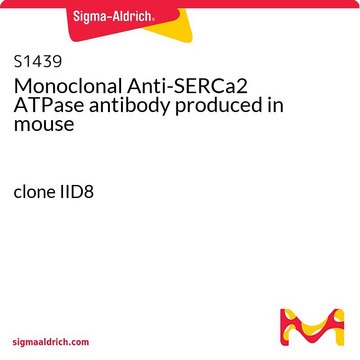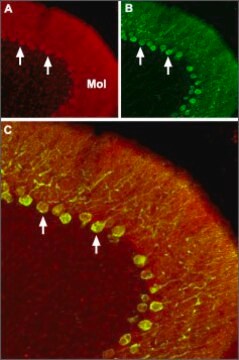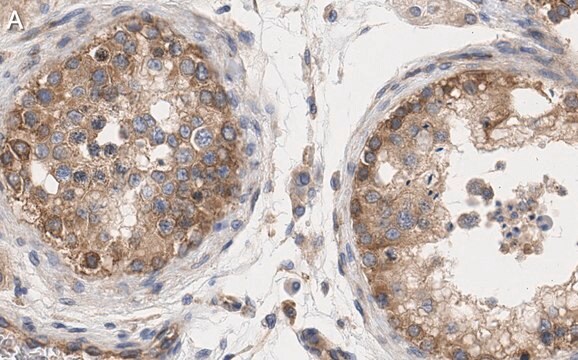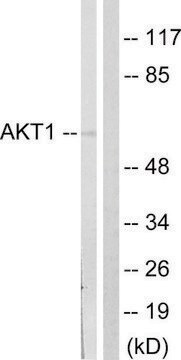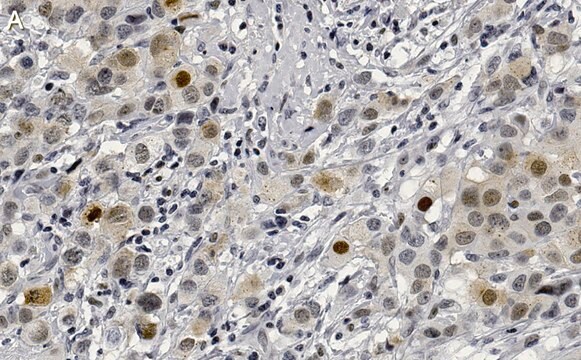詳細
We are committed to bringing you greener alternative products, which adhere to one or more of The 12 Principles of Green Chemistry.This antibody is Preservative-free, produced without the harm or sacrifice of animals and exceptionally stable to allow for ambient shipping and storage if needed and thus aligns with "Waste Prevention", "Designing Safer Chemicals" and "Design for Energy Efficiency".
Click here for more information.
ZooMAb® antibodies represent an entirely new generation of recombinant monoclonal antibodies.Each ZooMAb® antibody is manufactured using our proprietary recombinant expression system, purified to homogeneity, and precisely dispensed to produce robust and highly reproducible lot-to-lot consistency. Only top-performing clones are released for use by researchers. Each antibody is validated for high specificity and affinity across multiple applications, including its most commonly used application. ZooMAb® antibodies are reliably available and ready to ship when you need them.
特異性
Clone 1D18 is a ZooMAb® Rabbit recombinant monoclonal antibody that specifically detects PI-3 kinase p110β. It targets an epitope within 23 amino acids from the N-terminal half.
免疫原
KLH-conjugated linear peptide corresponding to 23 amino acids from the N-terminal half of human PI-3 kinase p110β.
アプリケーション
Quality Control Testing
Evaluated by Western Blotting in HepG2 cell lysate.
Western Blotting Analysis: A 1:1,000 dilution of this antibody detected PI3 Kinase p110 β in HepG2 cell lysate.
Tested applications
Western Blotting Analysis: A 1:1,000 dilution from a representative lot detected PI3 Kinase p110 β in K562 and A431 cell lysates.
Affinity Binding Assay: A representative lot of this antibody bound PI3 Kinase p110 β peptide with a KD of 1.0 x 10-12 in an affinity binding assay.
Immunohistochemistry (Paraffin) Analysis: A 1:100 dilution from a representative lot detected PI3 Kinase p110 β in human testis tissue sections.
Note: Actual optimal working dilutions must be determined by end user as specimens, and experimental conditions may vary with the end user
Evaluated by Western Blotting in HepG2 cell lysate.
Western Blotting Analysis: A 1:1,000 dilution of this antibody detected PI3 Kinase p110 β in HepG2 cell lysate.
ターゲットの説明
Phosphatidylinositol 4,5-bisphosphate 3-kinase catalytic subunit beta isoform (UniProt: P42338; also known as EC:2.7.1.153, PI3-kinase subunit beta, PI3K-beta, PI3Kbeta, PtdIns-3-kinase subunit beta, Phosphatidylinositol 4,5-bisphosphate 3-kinase 110 kDa catalytic subunit beta, PtdIns-3-kinase subunit p110-beta, p110beta) is encoded by the PIK3CB (also known as PIK3C1) gene (Gene ID: 5291) in human. PI3 Kinase is a ubiquitously expressed, heterodimeric complex composed of an 85 kDa regulatory subunit and a 110 kDa catalytic subunit. Following ligand binding to receptor and activation of receptor tyrosine kinase, the p85/p110 complex is recruited to the receptor by interaction of the SH2 domain of p85 with consensus phosphotyrosine residues on receptor tyrosine kinase. This allows the p110 catalytic subunit to come in close proximity to its lipid substrates in the cell membrane. The interaction of a receptor tyrosine kinase with the p85 subunit relieves the inhibitory effect of p85 on the p110 catalytic subunit. The catalytic loop of p110 catalytic unit is localized in amino acids 916-924 and the activation loop resides in amino acids 935-961. Active PI3 kinase phosphorylates phosphatidylinositol derivatives at position 3 of the inositol ring to produce 3-phosphoinositides. It uses ATP and PtdIns(4,5)P2 to generate phosphatidylinositol 3,4,5-trisphosphate (PIP3), which plays a key role by recruiting PH domain-containing proteins to the membrane, including AKT1 and phosphoinositide-dependent kinase 1 (PDK1) that activate signaling cascades involved in cell growth, survival, proliferation, motility, and morphology. PI 3-kinase activity is tightly regulated in normal cells. Its over-activation can perturb the control mechanisms for cell growth and survival and contribute to metastatic competence and resistance to chemotherapy. Abnormal activation of PI 3-kinases is seen in several forms of cancer. About 30% of solid tumors contain mutations in the catalytic unit of their PI 3-kinase. PI3 kinase also plays a critical role in insulin-stimulated increase in glucose uptake and glycogen synthesis in insulin-sensitive tissues. This ZooMAbZooMAb® recombinant monoclonal antibody, generated by our propriety technology, offers significantly enhanced specificity, affinity, reproducibility, and stability over conventional monoclonals. (Ref.: Müller R., et al. (2013). Front. Cell. Neurosci. 7; 24; Jia, S., et al. (2008). Nature. 454(7205); 776-779).
物理的形状
Purified recombinant rabbit monoclonal antibody IgG, lyophilized in PBS with 5% Trehalose, normal appearance a coarse or translucent resin. The PBS/trehalose components in the ZooMAb formulation can have the appearance of a semi-solid (bead like gel) after lyophilization. This is a normal phenomenon. Please follow the recommended reconstitution procedure in the data sheet to dissolve the semi-solid, bead-like, gel-appearing material. The resulting antibody solution is completely stable and functional as proven by full functional testing. Contains no biocide or preservatives, such as azide, or any animal by-products. Larger pack sizes provided as multiples of 25 μL.
再構成
300 μg/mL after reconstitution at 25 μL per vial. Please refer to guidance on suggested starting dilutions and/or titers per application and sample type.
保管および安定性
Recommend storage of lyophilized product at 2-8°C; Before reconstitution, micro-centrifuge vials briefly to spin down material to bottom of the vial; Reconstitute each vial by adding 25 μL of filtered lab grade water or PBS; Reconstituted antibodies can be stored at 2-8°C, or -20°C for long term storage. Avoid repeated freeze-thaws.
法的情報
ZooMAb is a registered trademark of Merck KGaA, Darmstadt, Germany
免責事項
Unless otherwise stated in our catalog or other company documentation accompanying the product(s), our products are intended for research use only and are not to be used for any other purpose, which includes but is not limited to, unauthorized commercial uses, in vitro diagnostic uses, ex vivo or in vivo therapeutic uses or any type of consumption or application to humans or animals.

